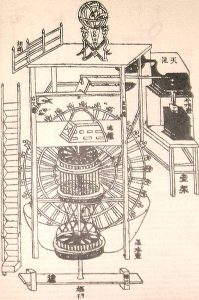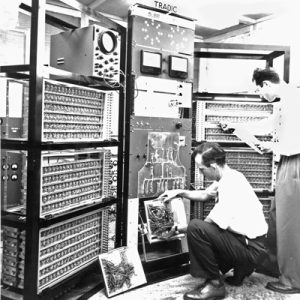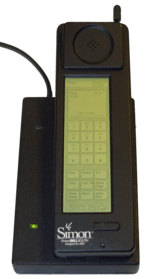Important Innovations in Computing
Computers are incredible machines! Our modern world just would not be the same without them! Here are some fun facts about the history of computers:
Abacus, Ancient Sumeria, 2700-2500 BCE

The abacus was the first purpose-built device used for making mathematical computations. Originally invented in Sumeria, the abacus was a staple in business and classrooms for centuries, until the invention of the pocket calculator.
Dongwu Che "South-pointing Chariot", China, 500 BCE

The Dongwu Che, or South-facing Chariot, was an instrument of war developed centuries ago to aid in siege efforts against enemy fortresses. The earliest confirmed writing of one was in 200 BCE, though they likely existed earlier. The chariot uses a precise differential gear which allows the device to always stay orientated in a certain direction no matter how it is moved, hence the name.
Antikythera Device, Greece, 2nd Century BCE

The Antikythera Device was discovered in a shipwreck off the coast of Crete in 1902, and was one of the oldest artifacts ever containing a gear. The machine was an early mechanical version of an astrolabe, used by seafarers to chart the stars.
Arabic astrolabe, Arabia, 11th Century

The first astrolabes appeared widely nearly a thousand years later. These devices were very intricate and usually made of brass. Navigators could use them for a variety of functions, such as determining latitude, identifying stars, and local time.
Water Clock, Song Dynasty China, 13th Century

Water clocks were among the earliest clocks in history. Though the earliest examples predate the Roman Empire, by the 13th century, they were impressively large and complex and immensely useful in astronomy.
Prague Orloj, Prague, Poland, 1410

The Prague Orloj is an astronomical clock in Prague, Poland. Originally constructed in 1410, it was one of the first of it's kind ever produced, and remains the oldest such clock still in service.
Babbage Analytical Engine, England, 1837

The first digital computer was conceived, designed, and partially built by Charles Babbage. Though incomplete during his lifetime, later engineers and computer programmers were able to replicate his invention in 1992, based on his plans and using material available to Babbage. This deemed his invention a viable success.
The Thrilling Adventures of Lovelace and Babbage
Harvard Computers, 1875

As early as the 18th century and the birth of modern astrophysics, there was a need for dedicated professionals who did nothing but compute the trajectories of celestial bodies. Various universities and military organizations made use of these intelligent people. In 1875, Harvard University had an entire staff of them. Human computers, notably including an impressively growing number of women, played major roles in computing ballistics trajectories in World War I, World War II, and the early Space Race.
ENIAC, US Army, 1945

By 1936, computer engineers were building on Babbage's and Alan Turing's work to develop the digital computer. While digital computers were built before then, the ENIAC was the first such computer to include various computational features and be generally programmable for a variety of tasks. The US Army used it for ballistic trajectory solutions.
Transistor Computer, 1956

The earliest digital computers made use of vacuum tubes, filled entire rooms, and could usually only work on a small number of calculations at a time. The electronic transistor allowed computers to be built much more efficiently, allowing for far smaller and more powerful devices. These are the kinds of computers that would ultimately help power Mission Control and the various NASA spacecraft.
Kenbak-1, 1970

Kenbak Corporation's 1970 is largely considered to be the first commercially sold computer for home use. It was a very rudimentary device, with no visual display, useful for teaching hobbyists how to perform basic programming. Only 44 units were ever sold.
Apple II, 1973

Steve Wozniak and Steve Jobbs started Apple Corporation out of their garage, building computers by hand for local computer stores. The Apple II is considered the first commercially successful personal computer to achieve widespread acclaim. Neither the Apple II or the later-released Macintosh computers possessed harddrives.
GRiD Compass Laptop, 1982

As computers became more efficient and decreased in size, they also became portable. The GRiD Compass was the first laptop designed with a clamshell hinge. Virtually all modern laptops use a clamshell aesthetic. The GRiD Compass was heavily used by the military and NASA, including on the space shuttle.
IBM Simon, 1992

Meet the world's first smartphone. By 1992, computer microprocessors were so small and so powerful, companies could now make computers that could fit in the palm of your hand. It had 1 MB of RAM and 1 MB of storage.
Deep Blue, 1995

The late 80s and 90s saw explosive growth in computer efficiency and performance. Programs became more complex too, and software developers figured out how to make computer versions of classic games, including solitaire, pinball, and chess. By 1987, specially-designed super computers were capable of defeating experienced human opponents. In 1995, Deep Blue was sophisticated enough to challenge chess world champion Garry Kasparov, though it only won two games out of seven. Two years later after a few upgrades, it decisively won.
Texas Instruments TI-73 Graphing Calculator, 1998

Many readers have probably heard this claim: your calculator is more powerful than the Apollo 11 computer - it actually is! The TI-73, originally released in 1998, had 90% of the ROM and 8x more RAM than the computer that landed men on the moon in 1969. Subsequent models dramatically improved in capability and ease of programming. So yes, your calculator totally could have done it with the right programming. It's impressive seeing how far things improved in just 30 years.
iPhone, 2007

It wasn't the first smartphone, or even the first successful one, but the iPhone brought smartphones to mainstream, being the first phone to combine all the common features of a modern computer. Today, virtually every phone on the market follows this design.
Play Station 5, 2020

Video game consoles are of course a form of computer, optimized for playing video games on your home television. The Play Station 5 is one the most popular and powerful modern consoles, capable of playing thousands of different games, some with near lifelike visuals and physics.
FRONTIER Supercomputer, Oak Ridge National Laboratory, 2022

Housed at Oakridge, Tennessee, the FRONTIER Supercomputer is the (current) reigning champion of the computer world, capable of just over 1 exaflop of calculations. How much is an exaflop? Today's video game consoles and consumer graphics cards measure performance in terms of teraflops, with a teraflop being one trillion floating operational points (i.e. commands) done. FRONTIER is capable of performing one quintilion calculations, or a billion billion! Amazing!
Thanks for reading!


Add a comment to: Important Innovations in Computing